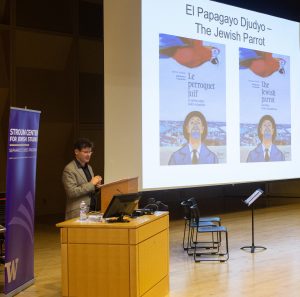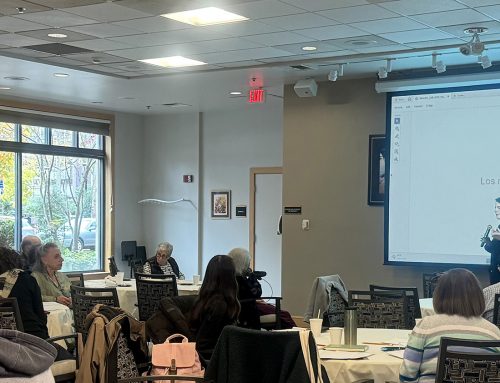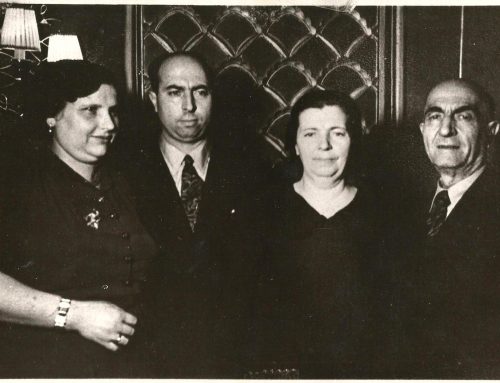By Julie Tolmie
At Ladino Day 2018, I was struck by a question author François Azar posed: has publishing Sephardic folktales like “El Papagayo Djudyo” (“The Jewish Parrot,” 2014), which was read onstage that night, made them “less Sephardic,” less the possession of the Sephardic community?
Although Azar argued that publishing folktales did no such thing, I could see how one might believe the opposite. The folktales that Azar published have lost some of the elements that made their original form — oral stories — uniquely Sephardic. Azar described Sephardic folktales as something that had previously been private. These folktales were exchanged between just a few people: the storyteller and the audience in front of him/her. More importantly, however, they were exchanged between Ladino-speaking Sephardic Jews.
With Azar’s publication, the stories are now displayed in illustrated books, reaching an audience across the globe, many of whom do not speak Ladino or have any connection to Sephardic culture. The stories reach these people not just through the picture books themselves, but also via events like Ladino Day, at which “The Jewish Parrot” was read in Ladino with English translations projected on a large screen.

Author François Azar, the featured speaker at the 6th annual International Ladino Day celebration.
Publicizing the folktales this way opens them up to criticism and judgement by the larger non-Sephardic community — criticism from which they had previously been insulated. Sephardic storytellers of old used the privacy oral Ladino offered to interweave their tales with social commentary. And while Azar’s published Sephardic folktales maintain this commentary, Azar’s path to publication demonstrates a definite awareness of a global audience. In making “The Jewish Parrot,” Azar noted that he felt it was important for the book’s illustrations to be done by the best artist possible in order to present the Sephardic community in the best possible light.
But he may not have undertaken this effort to present the Sephardic community in the best possible light for the benefit of non-Sephardic people alone. Azar disclosed to my class “The Sephardic Diaspora: 1492-Present” that he also felt it was important for the Sephardic group Aki Estamos’ magazine, Kaminando i Avlando, to feature the best photographers, graphic designers, and writers possible.
While Kaminando i Avlando is published in French as well as Ladino, and therefore accessible to more than a Ladino-speaking Sephardic audience, it is the magazine of a Sephardic group. It is therefore likely safe to say that the vast majority of the magazine’s subscribers and readers are Sephardic Jews. Azar’s goal in making his publications widely intelligible and aesthetically pleasing, and in opening them up to the larger community via events like Ladino Day, may therefore also have been to make both accessible and attractive to not just the outside world, but also to Sephardic Jews themselves.
My experience at Ladino Day indicates as much; I doubt that the young man I met at Ladino Day, who was part Sephardic but grew up in a culturally Ashkenazi and Greek household and had never met another Sephardic Jew outside of his family before attending Ladino Day, would have understood the “The Jewish Parrot” if not for the book’s English translation.
It seems to me, therefore, that while published Sephardic folktales may have lost some of what made them uniquely Sephardic, they have gained the ability to remind the global Sephardic community what it meant and means to be Sephardic. Sephardic folktales, and Ladino Day, are not just meaningful for how they convey the way the Sephardic community used to look and the way it navigated the constraints of larger society, but also for the ways in which they can describe this history to new faces and introduce those new faces to the Sephardic community that still exists today.
*Watch the full video of Ladino Day 2018 now*
Further reading
- “Seattle is a Sephardic country: Behind the scenes of Ladino Day 2018” by Makena Mezistrano (2019)
- “Aki estamos (we are here): Revitalizing Ladino in Paris and beyond” by Molly FitzMorris (2018)
- To read more about past Ladino Days, visit our Ladino Day Archive
 Julie Tolmie is an undergrad student at the University of Washington. Julie attended Devin Naar’s course “The Sephardic Diaspora: 1492-Present” during the 2018 Fall semester.
Julie Tolmie is an undergrad student at the University of Washington. Julie attended Devin Naar’s course “The Sephardic Diaspora: 1492-Present” during the 2018 Fall semester.







Leave A Comment